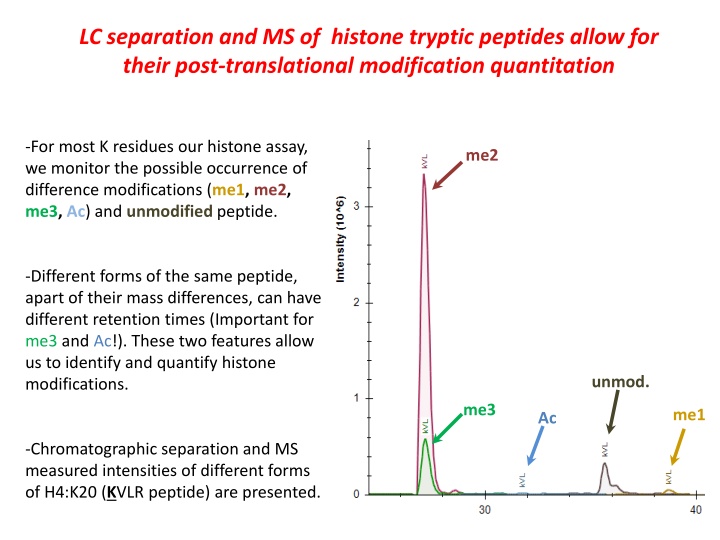
Quantitation of Histone Post-Translational Modifications
"Learn how LC separation and MS of histone tryptic peptides enable the quantitation of post-translational modifications, using MRM analysis for targeted peptide quantitation in histone assays. Explore examples and results showcasing relative abundances of histone mark modifications across samples." (283 characters)
Download Presentation

Please find below an Image/Link to download the presentation.
The content on the website is provided AS IS for your information and personal use only. It may not be sold, licensed, or shared on other websites without obtaining consent from the author. If you encounter any issues during the download, it is possible that the publisher has removed the file from their server.
You are allowed to download the files provided on this website for personal or commercial use, subject to the condition that they are used lawfully. All files are the property of their respective owners.
The content on the website is provided AS IS for your information and personal use only. It may not be sold, licensed, or shared on other websites without obtaining consent from the author.
E N D
Presentation Transcript
LC separation and MS of histone tryptic peptides allow for their post-translational modification quantitation -For most K residues our histone assay, we monitor the possible occurrence of difference modifications (me1, me2, me3, Ac) and unmodified peptide. me2 -Different forms of the same peptide, apart of their mass differences, can have different retention times (Important for me3 and Ac!). These two features allow us to identify and quantify histone modifications. unmod. me3 me1 Ac -Chromatographic separation and MS measured intensities of different forms of H4:K20 (KVLR peptide) are presented.
MRM-multi reaction monitoring -Our histone assay is targeted type of analysis based on MRM (multi reaction monitoring) technology -It means that triple-quad mass spectrometer is programmed to fragment only specific precursor peptides and measure intensity of specific products ions -For example for unmodified AKAKTR peptide: double charged parent ion 421.7584 ++ was fragmented at retention time 31.4 min. resulting in series of product ions : y4 531.3249+ y3 460.2878+ b2 312.1918+ -Only these specific ions are monitored and use for quantitation. We call them peptide transitions.
Example of MRM analysis for unmodified peptide AKAKTR from H2A histone MRM event (which we called peptide transition) is repeated in each technical replicate of sample. Different line colors represent 3 different transition specific for unmodified H2A: AKAKTR peptide tech repl.1 tech repl.2 tech repl.3
MRM analysis in quantitation of histone posttranslational modifications Final results shown as percent of given modification in total pule of given peptide which was quantified. Error bars are are +/- one standard deviation obtained from sample technical replicate intensities. Relative quantitation of posttranslational modifications for H4: K20 residue (KVLR peptide) for single sample is presented.
MRM analysis in quantitation of histone posttranslational modifications Finally, results for many samples can be plotted simultaneously showing changes of relative abundances of histone mark modification. Relative quantitation of posttranslational modifications for H4: K20 residue (KVLR peptide) for 6 different samples shown.
